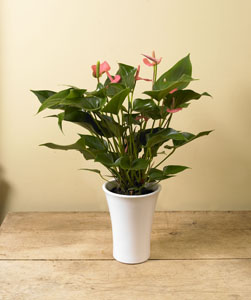Anthurium
 Also called the painted tongue, the flamingo flower and the tail flower, Anthurium is a vividly bright flower that got its name due to the single spadix that emerges upwards from the centre of the petals.
Also called the painted tongue, the flamingo flower and the tail flower, Anthurium is a vividly bright flower that got its name due to the single spadix that emerges upwards from the centre of the petals.
Description
The popular Anthurium flower is not a flower, but is really a coloured waxy leaf (the spathe) from which the spadix grows. The spadix is a form of fleshy spike that is covered in a cluster of small flowers, an effect known as inflorescence. These florets are the real Anthurium flowers and appear like a rough surface on the spadix. There are no flowers on the spathe and the plant as a whole can reach between 15 and 20 inches in height. The leaves are also able to swivel themselves to face the sun, in the manner of a sunflower.
Habitat
Anthurium is native to the tropical regions of the Americas, from Mexico to northern Argentina. It can grow evergreen, bushy or climbing. It may be cultivated from seed, or as a terrestrial plant and send out roots into the soil.
Availability
Because of its tropical origins, Anthuriums should always be kept warm and protected from frosts. Summer weather is preferable, although a greenhouse or conservatory may be a better position for it. Anthuriums give off a variety of fragrances when they flower to attract different pollinators.
Species
Anthurium is one of a variable and complex genus of plants from the Arum, also known as Araceae, or Calla family. There are over 1,000 species, all of which are noted for their leaf-like spathe and spadix of tiny flowers.
Care Tips
Anthuriums grow over a wide range of soil types, from heavy clays to sandy loams. The best condition is a good organic soil with good drainage. They need shallow planting, no more than about 2 inches, or the roots will rot. The best temperatures for growing the plants are between 21 and 32 degrees C. Temperatures below 12 degrees C could kill the plant.
Did You Know?
Arum, the genus of Anthuriums, derives from the Arabic word for “fire”. Despite its popularity, all parts of the Anthurium plants are poisonous. The sap can cause skin irritation and if any part of the plant is ingested, it can cause stomach disorders.
References
http://www.theflowerexpert.com/content/aboutflowers/exoticflowers/anthuriums
http://aggie-horticulture.tamu.edu/syllabi/302/new/family/araceae.html


